Financial Management Report: Dividend Policy and Investment Appraisal
VerifiedAdded on 2023/01/09
|17
|3970
|55
Report
AI Summary
This report delves into the core concepts of financial management, focusing on dividend policy and investment appraisal techniques. It begins by exploring the factors that influence a company's decisions regarding the size of its annual dividend, considering both the perspective of shareholders and the company's financial needs. The report then examines practical issues involved in determining dividend payments, such as tax implications, legal requirements, and investor preferences. The analysis extends to a case study involving Squeezeco, evaluating three dividend options: a cash dividend, a scrip dividend, and a share repurchase program. Furthermore, the report critically evaluates how companies make investment decisions. Finally, the report describes and critically evaluates various investment appraisal techniques, including the payback period, providing a comprehensive overview of financial management strategies and tools.

Financial Management
Paraphrase This Document
Need a fresh take? Get an instant paraphrase of this document with our AI Paraphraser

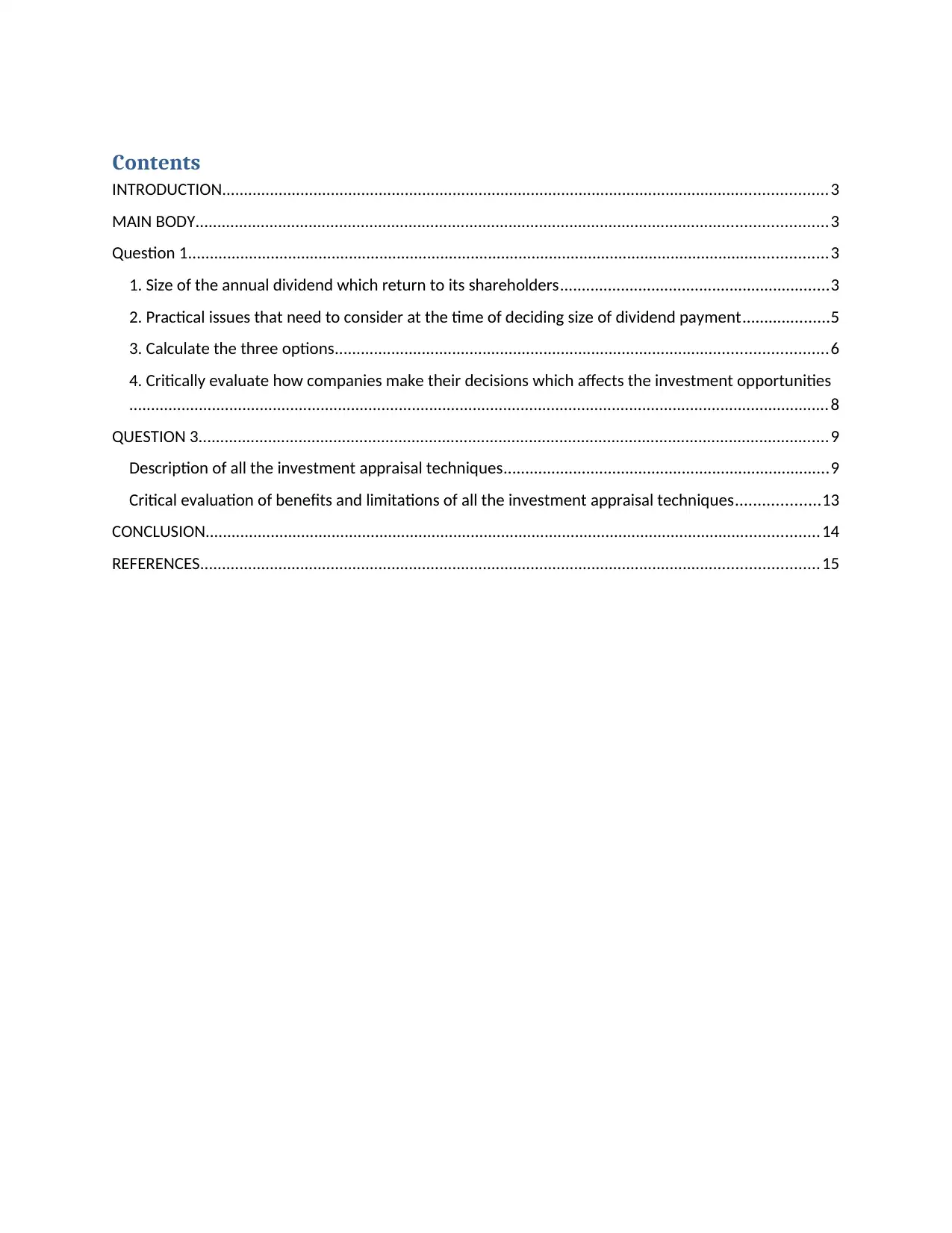
Contents
INTRODUCTION...........................................................................................................................................3
MAIN BODY.................................................................................................................................................3
Question 1...................................................................................................................................................3
1. Size of the annual dividend which return to its shareholders..............................................................3
2. Practical issues that need to consider at the time of deciding size of dividend payment....................5
3. Calculate the three options.................................................................................................................6
4. Critically evaluate how companies make their decisions which affects the investment opportunities
.................................................................................................................................................................8
QUESTION 3.................................................................................................................................................9
Description of all the investment appraisal techniques...........................................................................9
Critical evaluation of benefits and limitations of all the investment appraisal techniques...................13
CONCLUSION.............................................................................................................................................14
REFERENCES..............................................................................................................................................15
INTRODUCTION...........................................................................................................................................3
MAIN BODY.................................................................................................................................................3
Question 1...................................................................................................................................................3
1. Size of the annual dividend which return to its shareholders..............................................................3
2. Practical issues that need to consider at the time of deciding size of dividend payment....................5
3. Calculate the three options.................................................................................................................6
4. Critically evaluate how companies make their decisions which affects the investment opportunities
.................................................................................................................................................................8
QUESTION 3.................................................................................................................................................9
Description of all the investment appraisal techniques...........................................................................9
Critical evaluation of benefits and limitations of all the investment appraisal techniques...................13
CONCLUSION.............................................................................................................................................14
REFERENCES..............................................................................................................................................15
⊘ This is a preview!⊘
Do you want full access?
Subscribe today to unlock all pages.

Trusted by 1+ million students worldwide
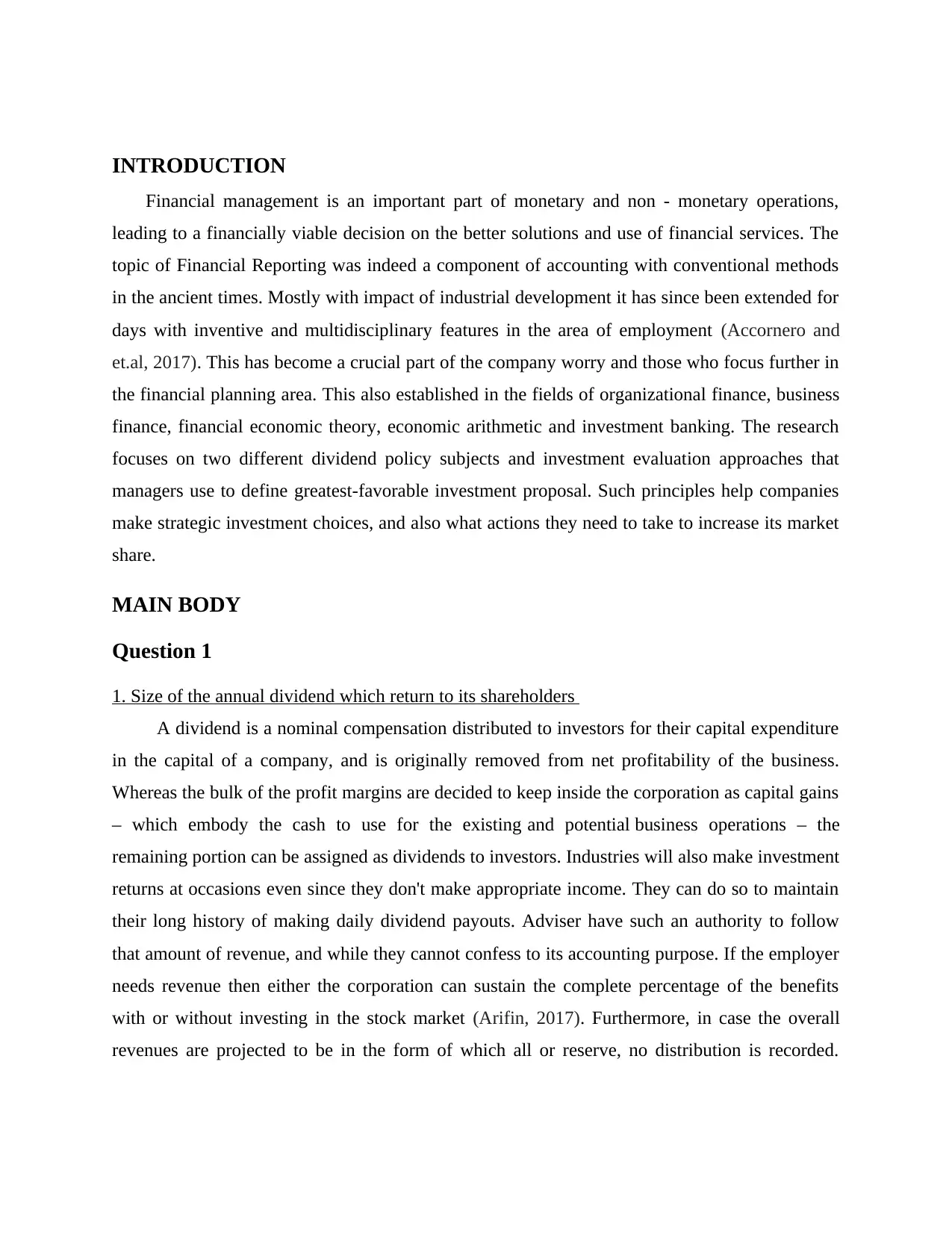
INTRODUCTION
Financial management is an important part of monetary and non - monetary operations,
leading to a financially viable decision on the better solutions and use of financial services. The
topic of Financial Reporting was indeed a component of accounting with conventional methods
in the ancient times. Mostly with impact of industrial development it has since been extended for
days with inventive and multidisciplinary features in the area of employment (Accornero and
et.al, 2017). This has become a crucial part of the company worry and those who focus further in
the financial planning area. This also established in the fields of organizational finance, business
finance, financial economic theory, economic arithmetic and investment banking. The research
focuses on two different dividend policy subjects and investment evaluation approaches that
managers use to define greatest-favorable investment proposal. Such principles help companies
make strategic investment choices, and also what actions they need to take to increase its market
share.
MAIN BODY
Question 1
1. Size of the annual dividend which return to its shareholders
A dividend is a nominal compensation distributed to investors for their capital expenditure
in the capital of a company, and is originally removed from net profitability of the business.
Whereas the bulk of the profit margins are decided to keep inside the corporation as capital gains
– which embody the cash to use for the existing and potential business operations – the
remaining portion can be assigned as dividends to investors. Industries will also make investment
returns at occasions even since they don't make appropriate income. They can do so to maintain
their long history of making daily dividend payouts. Adviser have such an authority to follow
that amount of revenue, and while they cannot confess to its accounting purpose. If the employer
needs revenue then either the corporation can sustain the complete percentage of the benefits
with or without investing in the stock market (Arifin, 2017). Furthermore, in case the overall
revenues are projected to be in the form of which all or reserve, no distribution is recorded.
Financial management is an important part of monetary and non - monetary operations,
leading to a financially viable decision on the better solutions and use of financial services. The
topic of Financial Reporting was indeed a component of accounting with conventional methods
in the ancient times. Mostly with impact of industrial development it has since been extended for
days with inventive and multidisciplinary features in the area of employment (Accornero and
et.al, 2017). This has become a crucial part of the company worry and those who focus further in
the financial planning area. This also established in the fields of organizational finance, business
finance, financial economic theory, economic arithmetic and investment banking. The research
focuses on two different dividend policy subjects and investment evaluation approaches that
managers use to define greatest-favorable investment proposal. Such principles help companies
make strategic investment choices, and also what actions they need to take to increase its market
share.
MAIN BODY
Question 1
1. Size of the annual dividend which return to its shareholders
A dividend is a nominal compensation distributed to investors for their capital expenditure
in the capital of a company, and is originally removed from net profitability of the business.
Whereas the bulk of the profit margins are decided to keep inside the corporation as capital gains
– which embody the cash to use for the existing and potential business operations – the
remaining portion can be assigned as dividends to investors. Industries will also make investment
returns at occasions even since they don't make appropriate income. They can do so to maintain
their long history of making daily dividend payouts. Adviser have such an authority to follow
that amount of revenue, and while they cannot confess to its accounting purpose. If the employer
needs revenue then either the corporation can sustain the complete percentage of the benefits
with or without investing in the stock market (Arifin, 2017). Furthermore, in case the overall
revenues are projected to be in the form of which all or reserve, no distribution is recorded.
Paraphrase This Document
Need a fresh take? Get an instant paraphrase of this document with our AI Paraphraser
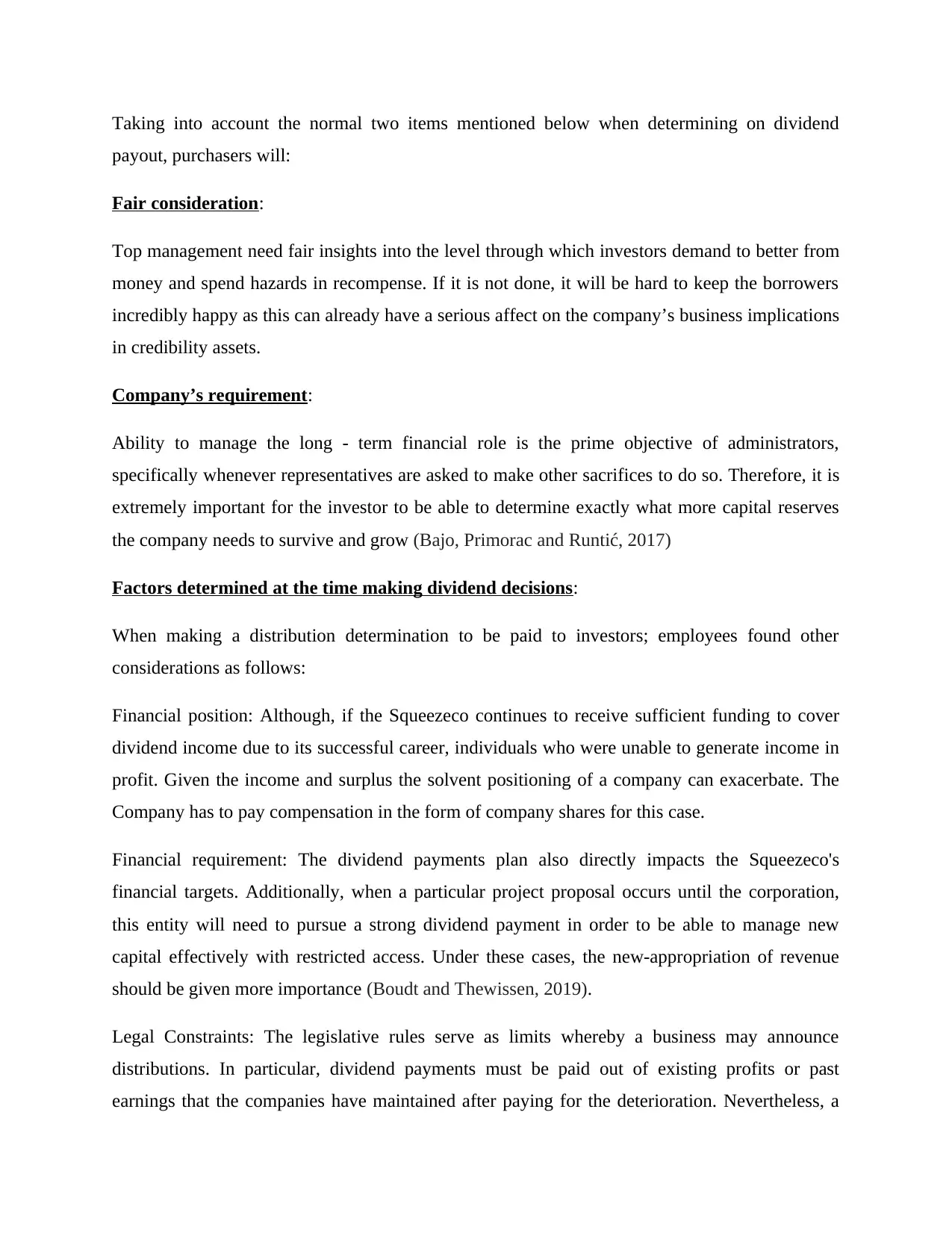
Taking into account the normal two items mentioned below when determining on dividend
payout, purchasers will:
Fair consideration:
Top management need fair insights into the level through which investors demand to better from
money and spend hazards in recompense. If it is not done, it will be hard to keep the borrowers
incredibly happy as this can already have a serious affect on the company’s business implications
in credibility assets.
Company’s requirement:
Ability to manage the long - term financial role is the prime objective of administrators,
specifically whenever representatives are asked to make other sacrifices to do so. Therefore, it is
extremely important for the investor to be able to determine exactly what more capital reserves
the company needs to survive and grow (Bajo, Primorac and Runtić, 2017)
Factors determined at the time making dividend decisions:
When making a distribution determination to be paid to investors; employees found other
considerations as follows:
Financial position: Although, if the Squeezeco continues to receive sufficient funding to cover
dividend income due to its successful career, individuals who were unable to generate income in
profit. Given the income and surplus the solvent positioning of a company can exacerbate. The
Company has to pay compensation in the form of company shares for this case.
Financial requirement: The dividend payments plan also directly impacts the Squeezeco's
financial targets. Additionally, when a particular project proposal occurs until the corporation,
this entity will need to pursue a strong dividend payment in order to be able to manage new
capital effectively with restricted access. Under these cases, the new-appropriation of revenue
should be given more importance (Boudt and Thewissen, 2019).
Legal Constraints: The legislative rules serve as limits whereby a business may announce
distributions. In particular, dividend payments must be paid out of existing profits or past
earnings that the companies have maintained after paying for the deterioration. Nevertheless, a
payout, purchasers will:
Fair consideration:
Top management need fair insights into the level through which investors demand to better from
money and spend hazards in recompense. If it is not done, it will be hard to keep the borrowers
incredibly happy as this can already have a serious affect on the company’s business implications
in credibility assets.
Company’s requirement:
Ability to manage the long - term financial role is the prime objective of administrators,
specifically whenever representatives are asked to make other sacrifices to do so. Therefore, it is
extremely important for the investor to be able to determine exactly what more capital reserves
the company needs to survive and grow (Bajo, Primorac and Runtić, 2017)
Factors determined at the time making dividend decisions:
When making a distribution determination to be paid to investors; employees found other
considerations as follows:
Financial position: Although, if the Squeezeco continues to receive sufficient funding to cover
dividend income due to its successful career, individuals who were unable to generate income in
profit. Given the income and surplus the solvent positioning of a company can exacerbate. The
Company has to pay compensation in the form of company shares for this case.
Financial requirement: The dividend payments plan also directly impacts the Squeezeco's
financial targets. Additionally, when a particular project proposal occurs until the corporation,
this entity will need to pursue a strong dividend payment in order to be able to manage new
capital effectively with restricted access. Under these cases, the new-appropriation of revenue
should be given more importance (Boudt and Thewissen, 2019).
Legal Constraints: The legislative rules serve as limits whereby a business may announce
distributions. In particular, dividend payments must be paid out of existing profits or past
earnings that the companies have maintained after paying for the deterioration. Nevertheless, a
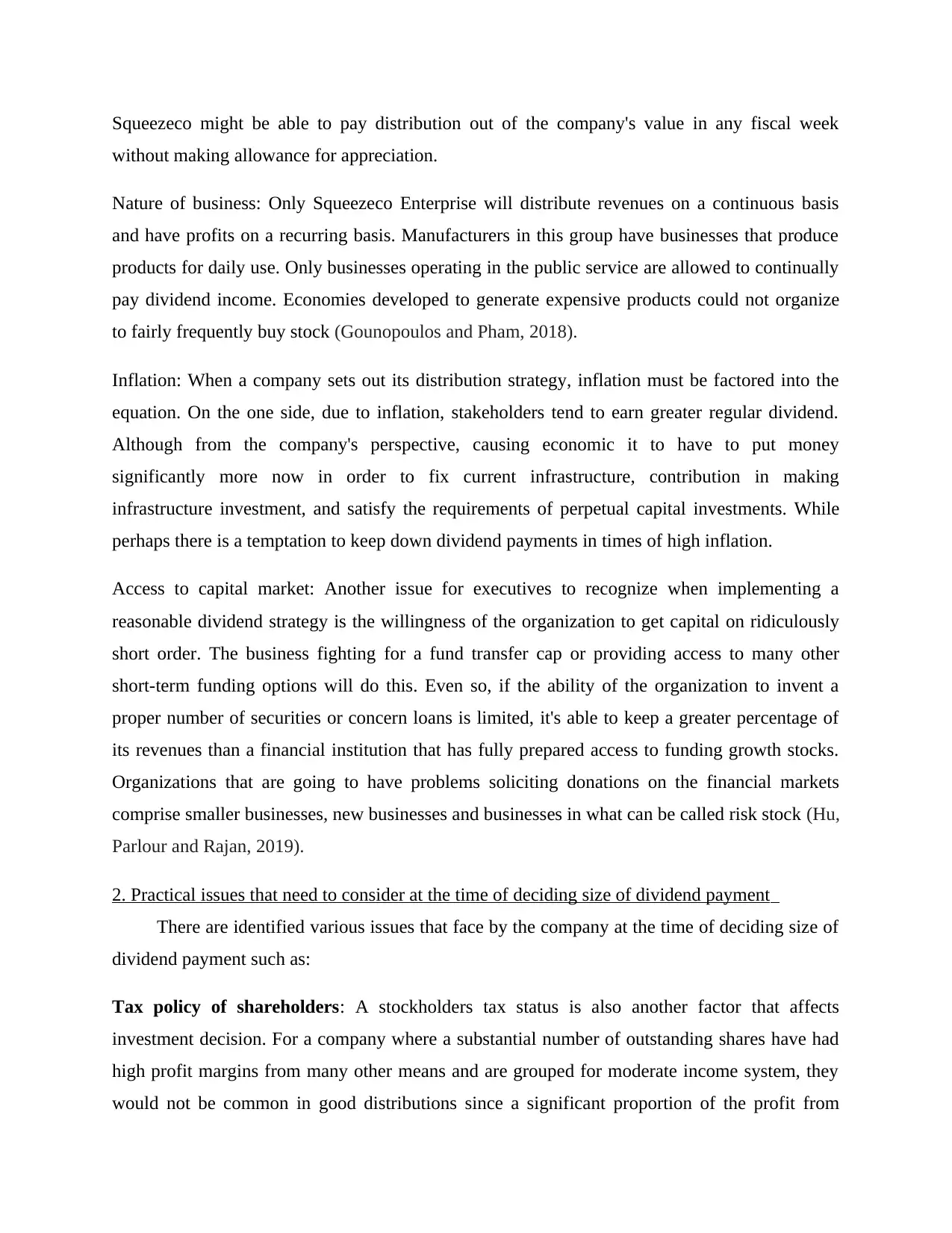
Squeezeco might be able to pay distribution out of the company's value in any fiscal week
without making allowance for appreciation.
Nature of business: Only Squeezeco Enterprise will distribute revenues on a continuous basis
and have profits on a recurring basis. Manufacturers in this group have businesses that produce
products for daily use. Only businesses operating in the public service are allowed to continually
pay dividend income. Economies developed to generate expensive products could not organize
to fairly frequently buy stock (Gounopoulos and Pham, 2018).
Inflation: When a company sets out its distribution strategy, inflation must be factored into the
equation. On the one side, due to inflation, stakeholders tend to earn greater regular dividend.
Although from the company's perspective, causing economic it to have to put money
significantly more now in order to fix current infrastructure, contribution in making
infrastructure investment, and satisfy the requirements of perpetual capital investments. While
perhaps there is a temptation to keep down dividend payments in times of high inflation.
Access to capital market: Another issue for executives to recognize when implementing a
reasonable dividend strategy is the willingness of the organization to get capital on ridiculously
short order. The business fighting for a fund transfer cap or providing access to many other
short-term funding options will do this. Even so, if the ability of the organization to invent a
proper number of securities or concern loans is limited, it's able to keep a greater percentage of
its revenues than a financial institution that has fully prepared access to funding growth stocks.
Organizations that are going to have problems soliciting donations on the financial markets
comprise smaller businesses, new businesses and businesses in what can be called risk stock (Hu,
Parlour and Rajan, 2019).
2. Practical issues that need to consider at the time of deciding size of dividend payment
There are identified various issues that face by the company at the time of deciding size of
dividend payment such as:
Tax policy of shareholders: A stockholders tax status is also another factor that affects
investment decision. For a company where a substantial number of outstanding shares have had
high profit margins from many other means and are grouped for moderate income system, they
would not be common in good distributions since a significant proportion of the profit from
without making allowance for appreciation.
Nature of business: Only Squeezeco Enterprise will distribute revenues on a continuous basis
and have profits on a recurring basis. Manufacturers in this group have businesses that produce
products for daily use. Only businesses operating in the public service are allowed to continually
pay dividend income. Economies developed to generate expensive products could not organize
to fairly frequently buy stock (Gounopoulos and Pham, 2018).
Inflation: When a company sets out its distribution strategy, inflation must be factored into the
equation. On the one side, due to inflation, stakeholders tend to earn greater regular dividend.
Although from the company's perspective, causing economic it to have to put money
significantly more now in order to fix current infrastructure, contribution in making
infrastructure investment, and satisfy the requirements of perpetual capital investments. While
perhaps there is a temptation to keep down dividend payments in times of high inflation.
Access to capital market: Another issue for executives to recognize when implementing a
reasonable dividend strategy is the willingness of the organization to get capital on ridiculously
short order. The business fighting for a fund transfer cap or providing access to many other
short-term funding options will do this. Even so, if the ability of the organization to invent a
proper number of securities or concern loans is limited, it's able to keep a greater percentage of
its revenues than a financial institution that has fully prepared access to funding growth stocks.
Organizations that are going to have problems soliciting donations on the financial markets
comprise smaller businesses, new businesses and businesses in what can be called risk stock (Hu,
Parlour and Rajan, 2019).
2. Practical issues that need to consider at the time of deciding size of dividend payment
There are identified various issues that face by the company at the time of deciding size of
dividend payment such as:
Tax policy of shareholders: A stockholders tax status is also another factor that affects
investment decision. For a company where a substantial number of outstanding shares have had
high profit margins from many other means and are grouped for moderate income system, they
would not be common in good distributions since a significant proportion of the profit from
⊘ This is a preview!⊘
Do you want full access?
Subscribe today to unlock all pages.

Trusted by 1+ million students worldwide
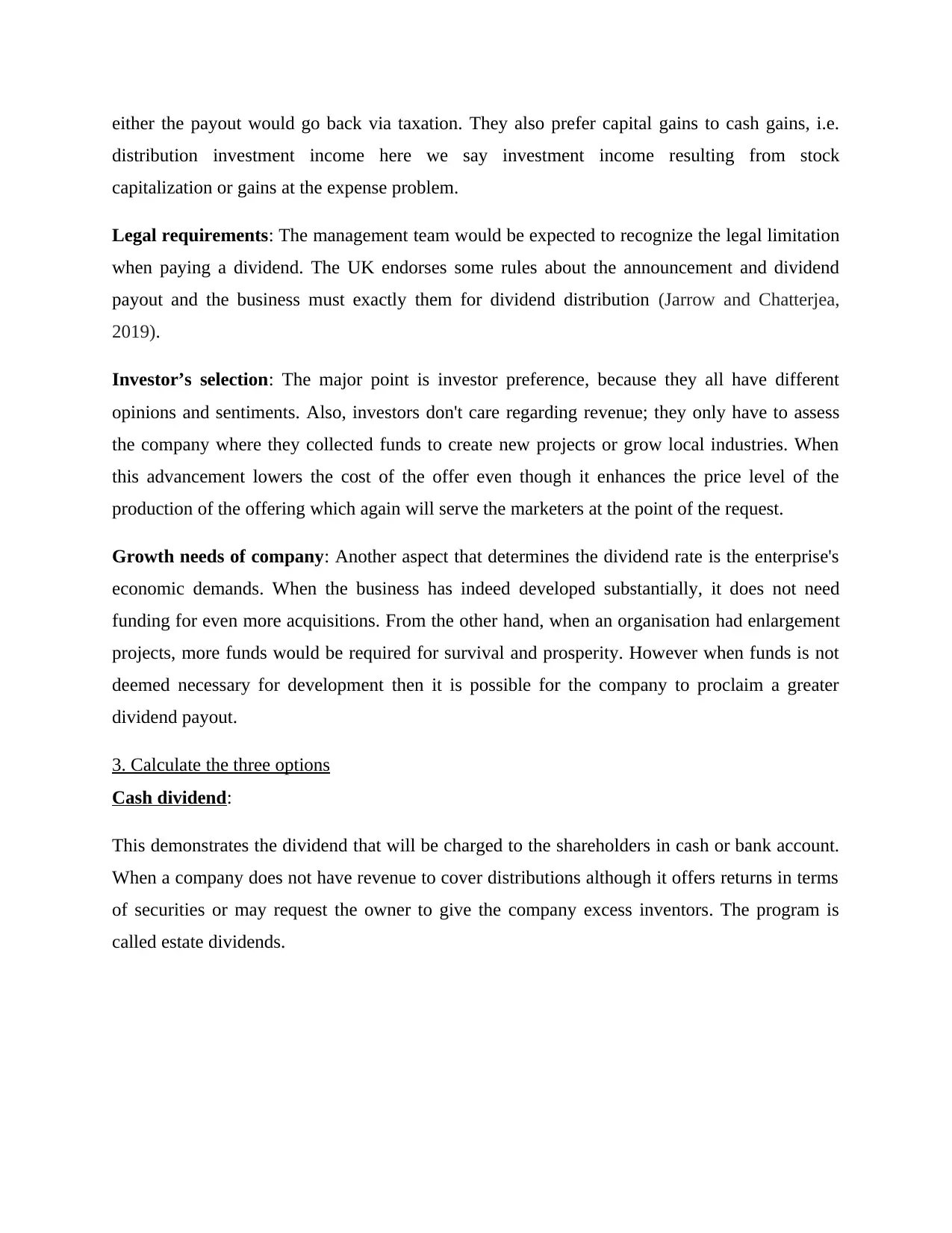
either the payout would go back via taxation. They also prefer capital gains to cash gains, i.e.
distribution investment income here we say investment income resulting from stock
capitalization or gains at the expense problem.
Legal requirements: The management team would be expected to recognize the legal limitation
when paying a dividend. The UK endorses some rules about the announcement and dividend
payout and the business must exactly them for dividend distribution (Jarrow and Chatterjea,
2019).
Investor’s selection: The major point is investor preference, because they all have different
opinions and sentiments. Also, investors don't care regarding revenue; they only have to assess
the company where they collected funds to create new projects or grow local industries. When
this advancement lowers the cost of the offer even though it enhances the price level of the
production of the offering which again will serve the marketers at the point of the request.
Growth needs of company: Another aspect that determines the dividend rate is the enterprise's
economic demands. When the business has indeed developed substantially, it does not need
funding for even more acquisitions. From the other hand, when an organisation had enlargement
projects, more funds would be required for survival and prosperity. However when funds is not
deemed necessary for development then it is possible for the company to proclaim a greater
dividend payout.
3. Calculate the three options
Cash dividend:
This demonstrates the dividend that will be charged to the shareholders in cash or bank account.
When a company does not have revenue to cover distributions although it offers returns in terms
of securities or may request the owner to give the company excess inventors. The program is
called estate dividends.
distribution investment income here we say investment income resulting from stock
capitalization or gains at the expense problem.
Legal requirements: The management team would be expected to recognize the legal limitation
when paying a dividend. The UK endorses some rules about the announcement and dividend
payout and the business must exactly them for dividend distribution (Jarrow and Chatterjea,
2019).
Investor’s selection: The major point is investor preference, because they all have different
opinions and sentiments. Also, investors don't care regarding revenue; they only have to assess
the company where they collected funds to create new projects or grow local industries. When
this advancement lowers the cost of the offer even though it enhances the price level of the
production of the offering which again will serve the marketers at the point of the request.
Growth needs of company: Another aspect that determines the dividend rate is the enterprise's
economic demands. When the business has indeed developed substantially, it does not need
funding for even more acquisitions. From the other hand, when an organisation had enlargement
projects, more funds would be required for survival and prosperity. However when funds is not
deemed necessary for development then it is possible for the company to proclaim a greater
dividend payout.
3. Calculate the three options
Cash dividend:
This demonstrates the dividend that will be charged to the shareholders in cash or bank account.
When a company does not have revenue to cover distributions although it offers returns in terms
of securities or may request the owner to give the company excess inventors. The program is
called estate dividends.
Paraphrase This Document
Need a fresh take? Get an instant paraphrase of this document with our AI Paraphraser
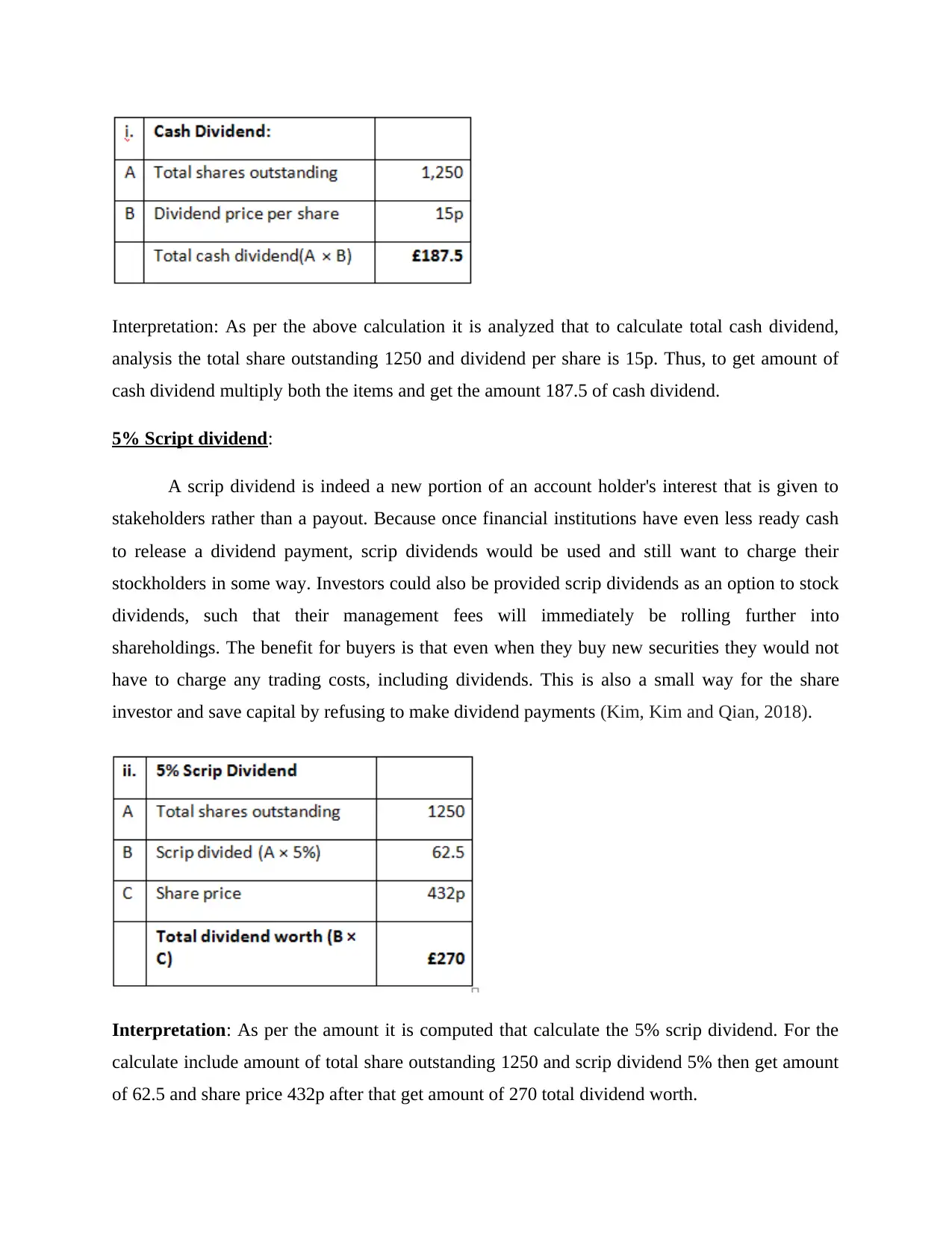
Interpretation: As per the above calculation it is analyzed that to calculate total cash dividend,
analysis the total share outstanding 1250 and dividend per share is 15p. Thus, to get amount of
cash dividend multiply both the items and get the amount 187.5 of cash dividend.
5% Script dividend:
A scrip dividend is indeed a new portion of an account holder's interest that is given to
stakeholders rather than a payout. Because once financial institutions have even less ready cash
to release a dividend payment, scrip dividends would be used and still want to charge their
stockholders in some way. Investors could also be provided scrip dividends as an option to stock
dividends, such that their management fees will immediately be rolling further into
shareholdings. The benefit for buyers is that even when they buy new securities they would not
have to charge any trading costs, including dividends. This is also a small way for the share
investor and save capital by refusing to make dividend payments (Kim, Kim and Qian, 2018).
Interpretation: As per the amount it is computed that calculate the 5% scrip dividend. For the
calculate include amount of total share outstanding 1250 and scrip dividend 5% then get amount
of 62.5 and share price 432p after that get amount of 270 total dividend worth.
analysis the total share outstanding 1250 and dividend per share is 15p. Thus, to get amount of
cash dividend multiply both the items and get the amount 187.5 of cash dividend.
5% Script dividend:
A scrip dividend is indeed a new portion of an account holder's interest that is given to
stakeholders rather than a payout. Because once financial institutions have even less ready cash
to release a dividend payment, scrip dividends would be used and still want to charge their
stockholders in some way. Investors could also be provided scrip dividends as an option to stock
dividends, such that their management fees will immediately be rolling further into
shareholdings. The benefit for buyers is that even when they buy new securities they would not
have to charge any trading costs, including dividends. This is also a small way for the share
investor and save capital by refusing to make dividend payments (Kim, Kim and Qian, 2018).
Interpretation: As per the amount it is computed that calculate the 5% scrip dividend. For the
calculate include amount of total share outstanding 1250 and scrip dividend 5% then get amount
of 62.5 and share price 432p after that get amount of 270 total dividend worth.
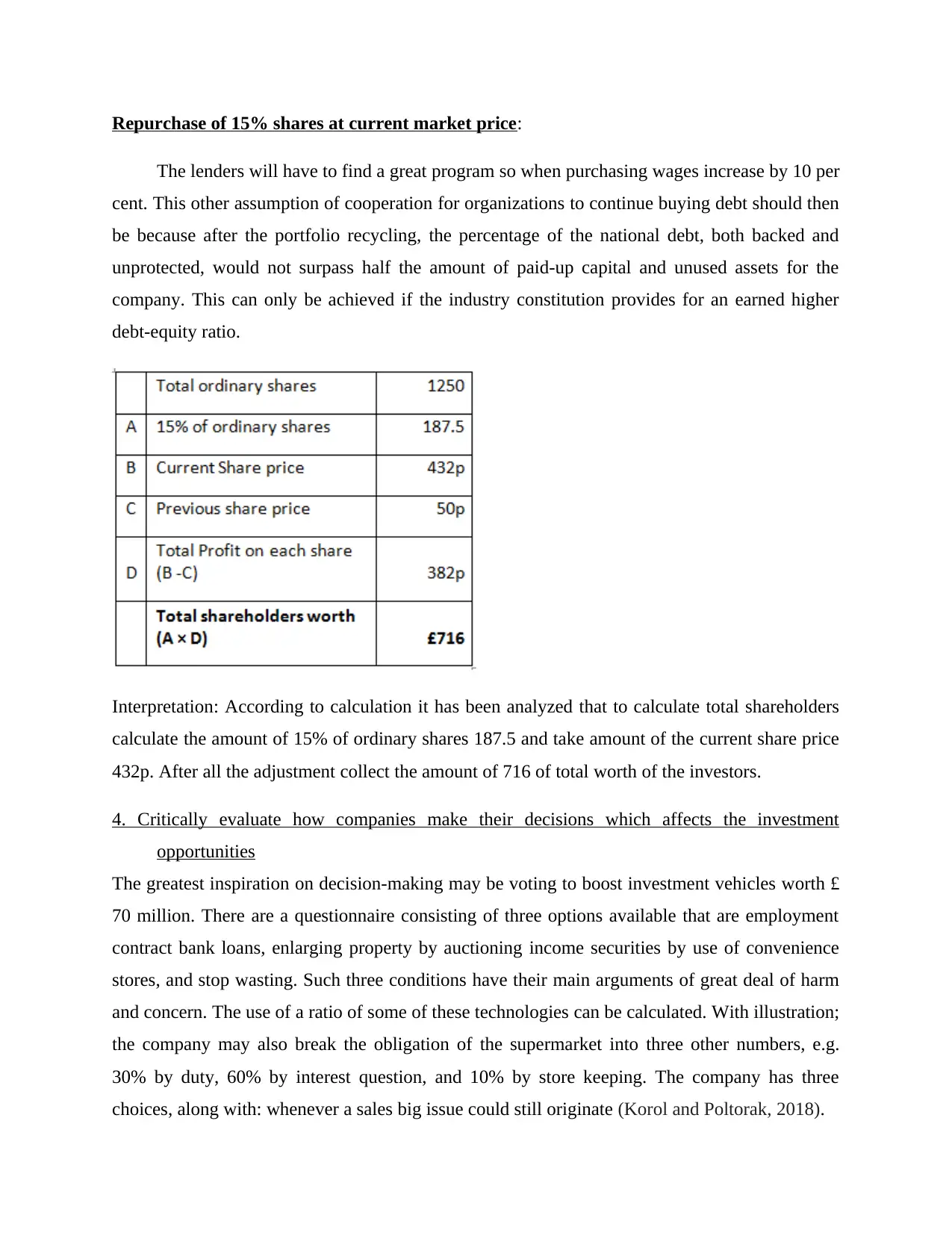
Repurchase of 15% shares at current market price:
The lenders will have to find a great program so when purchasing wages increase by 10 per
cent. This other assumption of cooperation for organizations to continue buying debt should then
be because after the portfolio recycling, the percentage of the national debt, both backed and
unprotected, would not surpass half the amount of paid-up capital and unused assets for the
company. This can only be achieved if the industry constitution provides for an earned higher
debt-equity ratio.
Interpretation: According to calculation it has been analyzed that to calculate total shareholders
calculate the amount of 15% of ordinary shares 187.5 and take amount of the current share price
432p. After all the adjustment collect the amount of 716 of total worth of the investors.
4. Critically evaluate how companies make their decisions which affects the investment
opportunities
The greatest inspiration on decision-making may be voting to boost investment vehicles worth £
70 million. There are a questionnaire consisting of three options available that are employment
contract bank loans, enlarging property by auctioning income securities by use of convenience
stores, and stop wasting. Such three conditions have their main arguments of great deal of harm
and concern. The use of a ratio of some of these technologies can be calculated. With illustration;
the company may also break the obligation of the supermarket into three other numbers, e.g.
30% by duty, 60% by interest question, and 10% by store keeping. The company has three
choices, along with: whenever a sales big issue could still originate (Korol and Poltorak, 2018).
The lenders will have to find a great program so when purchasing wages increase by 10 per
cent. This other assumption of cooperation for organizations to continue buying debt should then
be because after the portfolio recycling, the percentage of the national debt, both backed and
unprotected, would not surpass half the amount of paid-up capital and unused assets for the
company. This can only be achieved if the industry constitution provides for an earned higher
debt-equity ratio.
Interpretation: According to calculation it has been analyzed that to calculate total shareholders
calculate the amount of 15% of ordinary shares 187.5 and take amount of the current share price
432p. After all the adjustment collect the amount of 716 of total worth of the investors.
4. Critically evaluate how companies make their decisions which affects the investment
opportunities
The greatest inspiration on decision-making may be voting to boost investment vehicles worth £
70 million. There are a questionnaire consisting of three options available that are employment
contract bank loans, enlarging property by auctioning income securities by use of convenience
stores, and stop wasting. Such three conditions have their main arguments of great deal of harm
and concern. The use of a ratio of some of these technologies can be calculated. With illustration;
the company may also break the obligation of the supermarket into three other numbers, e.g.
30% by duty, 60% by interest question, and 10% by store keeping. The company has three
choices, along with: whenever a sales big issue could still originate (Korol and Poltorak, 2018).
⊘ This is a preview!⊘
Do you want full access?
Subscribe today to unlock all pages.

Trusted by 1+ million students worldwide
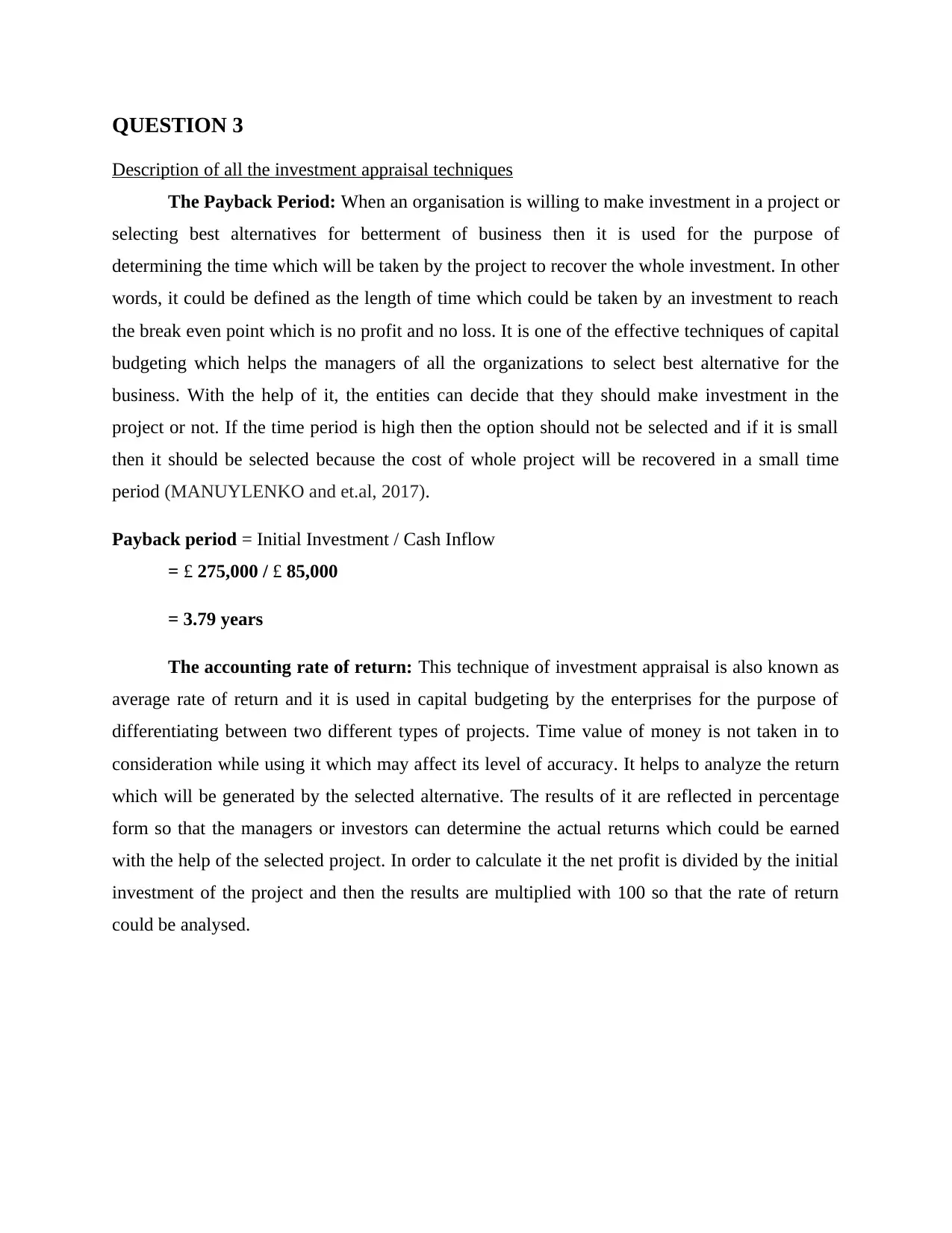
QUESTION 3
Description of all the investment appraisal techniques
The Payback Period: When an organisation is willing to make investment in a project or
selecting best alternatives for betterment of business then it is used for the purpose of
determining the time which will be taken by the project to recover the whole investment. In other
words, it could be defined as the length of time which could be taken by an investment to reach
the break even point which is no profit and no loss. It is one of the effective techniques of capital
budgeting which helps the managers of all the organizations to select best alternative for the
business. With the help of it, the entities can decide that they should make investment in the
project or not. If the time period is high then the option should not be selected and if it is small
then it should be selected because the cost of whole project will be recovered in a small time
period (MANUYLENKO and et.al, 2017).
Payback period = Initial Investment / Cash Inflow
= £ 275,000 / £ 85,000
= 3.79 years
The accounting rate of return: This technique of investment appraisal is also known as
average rate of return and it is used in capital budgeting by the enterprises for the purpose of
differentiating between two different types of projects. Time value of money is not taken in to
consideration while using it which may affect its level of accuracy. It helps to analyze the return
which will be generated by the selected alternative. The results of it are reflected in percentage
form so that the managers or investors can determine the actual returns which could be earned
with the help of the selected project. In order to calculate it the net profit is divided by the initial
investment of the project and then the results are multiplied with 100 so that the rate of return
could be analysed.
Description of all the investment appraisal techniques
The Payback Period: When an organisation is willing to make investment in a project or
selecting best alternatives for betterment of business then it is used for the purpose of
determining the time which will be taken by the project to recover the whole investment. In other
words, it could be defined as the length of time which could be taken by an investment to reach
the break even point which is no profit and no loss. It is one of the effective techniques of capital
budgeting which helps the managers of all the organizations to select best alternative for the
business. With the help of it, the entities can decide that they should make investment in the
project or not. If the time period is high then the option should not be selected and if it is small
then it should be selected because the cost of whole project will be recovered in a small time
period (MANUYLENKO and et.al, 2017).
Payback period = Initial Investment / Cash Inflow
= £ 275,000 / £ 85,000
= 3.79 years
The accounting rate of return: This technique of investment appraisal is also known as
average rate of return and it is used in capital budgeting by the enterprises for the purpose of
differentiating between two different types of projects. Time value of money is not taken in to
consideration while using it which may affect its level of accuracy. It helps to analyze the return
which will be generated by the selected alternative. The results of it are reflected in percentage
form so that the managers or investors can determine the actual returns which could be earned
with the help of the selected project. In order to calculate it the net profit is divided by the initial
investment of the project and then the results are multiplied with 100 so that the rate of return
could be analysed.
Paraphrase This Document
Need a fresh take? Get an instant paraphrase of this document with our AI Paraphraser
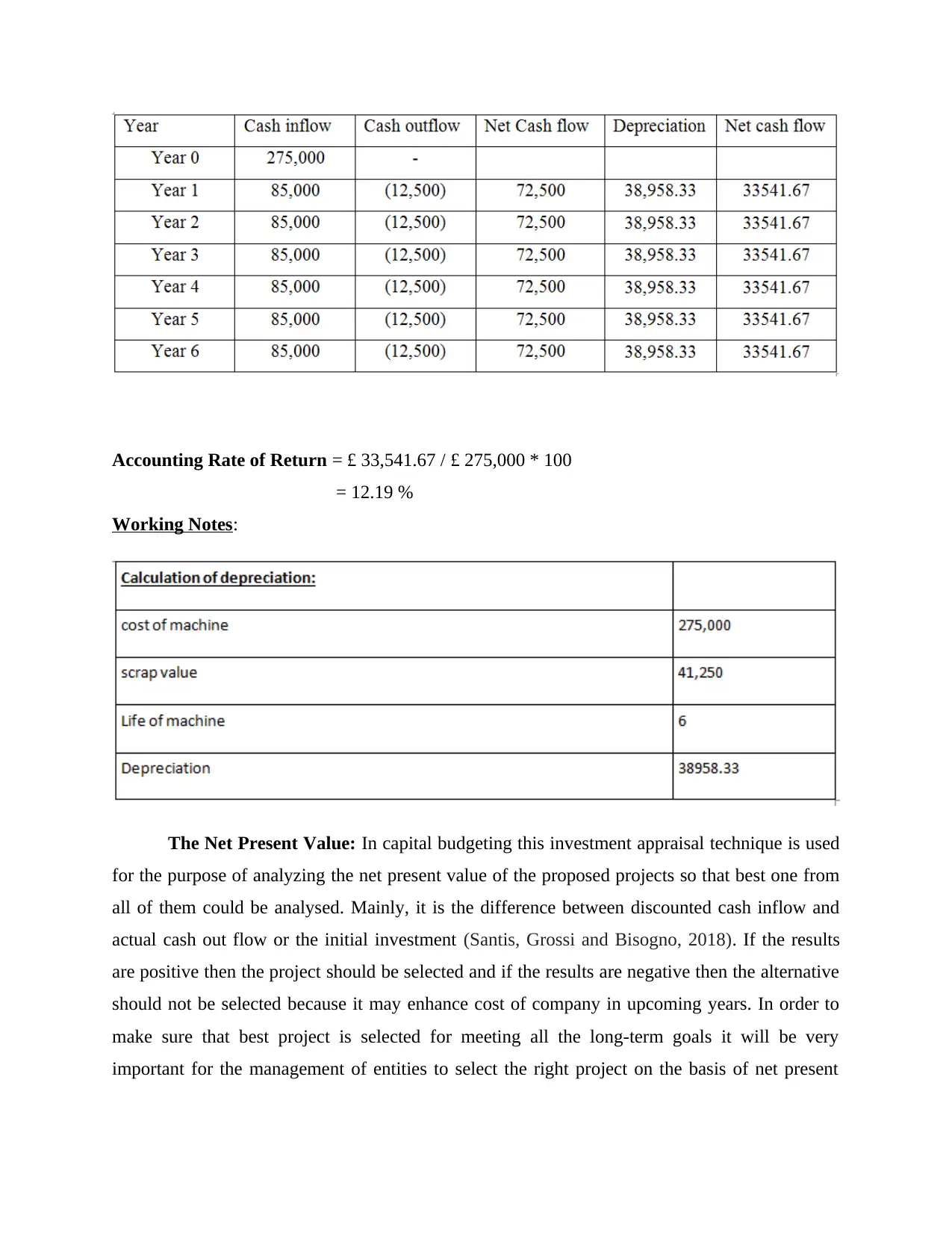
Accounting Rate of Return = £ 33,541.67 / £ 275,000 * 100
= 12.19 %
Working Notes:
The Net Present Value: In capital budgeting this investment appraisal technique is used
for the purpose of analyzing the net present value of the proposed projects so that best one from
all of them could be analysed. Mainly, it is the difference between discounted cash inflow and
actual cash out flow or the initial investment (Santis, Grossi and Bisogno, 2018). If the results
are positive then the project should be selected and if the results are negative then the alternative
should not be selected because it may enhance cost of company in upcoming years. In order to
make sure that best project is selected for meeting all the long-term goals it will be very
important for the management of entities to select the right project on the basis of net present
= 12.19 %
Working Notes:
The Net Present Value: In capital budgeting this investment appraisal technique is used
for the purpose of analyzing the net present value of the proposed projects so that best one from
all of them could be analysed. Mainly, it is the difference between discounted cash inflow and
actual cash out flow or the initial investment (Santis, Grossi and Bisogno, 2018). If the results
are positive then the project should be selected and if the results are negative then the alternative
should not be selected because it may enhance cost of company in upcoming years. In order to
make sure that best project is selected for meeting all the long-term goals it will be very
important for the management of entities to select the right project on the basis of net present
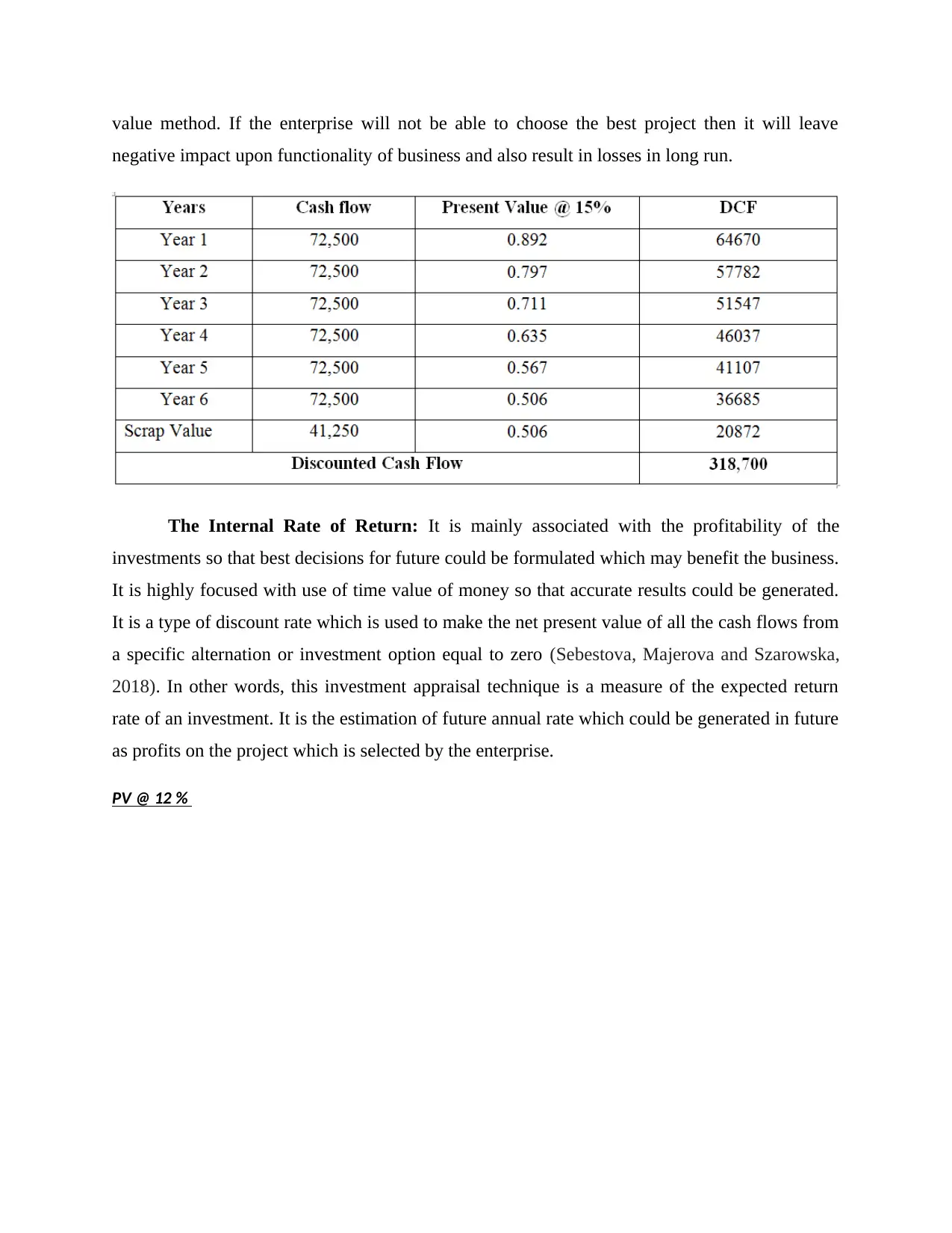
value method. If the enterprise will not be able to choose the best project then it will leave
negative impact upon functionality of business and also result in losses in long run.
The Internal Rate of Return: It is mainly associated with the profitability of the
investments so that best decisions for future could be formulated which may benefit the business.
It is highly focused with use of time value of money so that accurate results could be generated.
It is a type of discount rate which is used to make the net present value of all the cash flows from
a specific alternation or investment option equal to zero (Sebestova, Majerova and Szarowska,
2018). In other words, this investment appraisal technique is a measure of the expected return
rate of an investment. It is the estimation of future annual rate which could be generated in future
as profits on the project which is selected by the enterprise.
PV @ 12 %
negative impact upon functionality of business and also result in losses in long run.
The Internal Rate of Return: It is mainly associated with the profitability of the
investments so that best decisions for future could be formulated which may benefit the business.
It is highly focused with use of time value of money so that accurate results could be generated.
It is a type of discount rate which is used to make the net present value of all the cash flows from
a specific alternation or investment option equal to zero (Sebestova, Majerova and Szarowska,
2018). In other words, this investment appraisal technique is a measure of the expected return
rate of an investment. It is the estimation of future annual rate which could be generated in future
as profits on the project which is selected by the enterprise.
PV @ 12 %
⊘ This is a preview!⊘
Do you want full access?
Subscribe today to unlock all pages.

Trusted by 1+ million students worldwide
1 out of 17
Related Documents
Your All-in-One AI-Powered Toolkit for Academic Success.
+13062052269
info@desklib.com
Available 24*7 on WhatsApp / Email
![[object Object]](/_next/static/media/star-bottom.7253800d.svg)
Unlock your academic potential
Copyright © 2020–2025 A2Z Services. All Rights Reserved. Developed and managed by ZUCOL.





